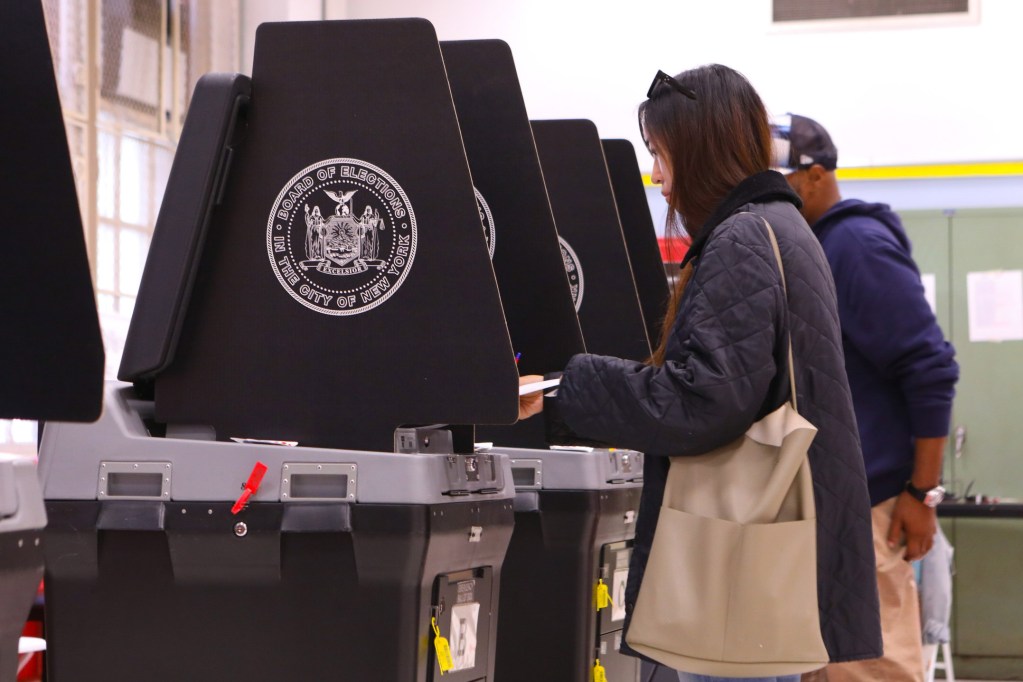New York City is the greatest city in the world, but we are a not-so-great city for voting.
The five boroughs rank 49th for turnout among big U.S. cities, according to a report published in December of last year from UC San Diego. So, among that sea of non-voters — who does come to the polls?
A reader of THE CITY asked us just that: With turnout low, who are the reliable voting blocs? And who never comes to the polls?
We have a good snapshot of this from the city’s Campaign Finance Board, which releases extensive data after every election on the neighborhoods across the city with the highest (and lowest) voter turnout.
Let’s look at the last mayoral election: 2021. Of the more than 4.9 million active registered voters for the general election that year, only 1.147 million cast votes, according to the CFB data. That’s just 23% of eligible city dwellers who actually exercised their right to vote.
The 2021 Democrat and Republican primaries — where there were more than 3.8 million eligible voters — saw more than 1 million people vote, or 26%. (Primary elections in New York City are often more important than the general, given the larger share of Democratic voters.)
Turnout isn’t equal among the five boroughs.
Manhattan had the highest voter turnout during the 2021 primary, with 33.4%. The highest voter turnout in the general election, though, was the Republican stronghold Staten Island, with 33.7% voting.
The borough with the lowest turnout for the primary and the general was The Bronx — 19.1% came out in June and 17.5% voted in November. Brooklyn’s primary turnout was 27.5%, and Queens had 25%; their general turnout were both above 22%.
Jerry Skurnik, a political consultant who works on voter turnout, said age is the most consistent factor when it comes to voting — although location is a big predictor, too..
“Older people vote at a higher turnout than younger people, that’s been true in primaries and general elections forever,” he told THE CITY.
The average age of a 2021 primary voter was 54, although the average age of a registered voter is 49, according to the CFB. (The median age of a New York City resident is 38.8, per the latest Census data.)
Older New Yorkers were the most likely to vote, according to the CFB numbers, with people between the ages of 70 and 79 turning out with 37% for the 2021 primary and nearly 38% for the general election. The next highest voting bloc was voters between the ages of 60 and 69.
Young people — not so much. The lowest voter turnout in 2021 was among people ages 18 and 29; nearly 18% voted for the primary, and just 11% voted in the general election.
The elections are also decided by certain neighborhoods, according to the data and experts. There was a more than 30% difference between the highest and lowest turnout neighborhoods in the 2021 primary.
Places like the west side of Manhattan, from Greenwich Village up to Columbia University, along with some parts of Brooklyn, are also high turnout areas, Skurnik said.
Data from the 2021 primary shows Park Slope and Carroll Gardens in Brooklyn had the highest turnout, with 44.3% voting. The Upper West Side of Manhattan had 41.6% turnout, and Brooklyn Heights and Fort Greene had 40.3%.
Southeast Queens has also historically been a high-turnout area, Skurnik noted. But the Queens neighborhoods with the highest turnout in the 2021 primary were Forest Hills, Rego Park, Sunnyside and Woodside, data shows.
The neighborhoods with the lowest turnout are all in The Bronx, with just 14% of eligible voters casting a ballot in Melrose, Mott Haven, and Port Morris. East Tremont and Belmont had 14.1% turnout, Hunts Point and Longwood had 14.6%, and Morrisania and Crotona Park East had 15% turnout.
Certain demographic factors also determine who votes — with college-educated voters turning out the most, said John Mollenkopf, the director of the Center for Urban Research at the CUNY Graduate Center.
“Regardless of demographics, college educated folks vote more,” he said.
But there are also anomalies, he said.
The most recent Census data found there are more than 1.5 million Asian Americans in New York City — and more than 735,000 are voting age, according to data compiled by the Asian American Foundation. That makes up 13% of the total voting-age New Yorkers, which has steadily increased since 2011.
Yet Asian voters have the smallest registration rates in the entire city, and smaller turnout rates.
Andrew Sta Ana, the interim co-executive director of the Asian American Federation, which is a nonprofit organization in New York City, said they’re working on voter education and plan to hold a town hall with mayoral candidates before the June 24 primary.
Their Ballot Builder is an interactive tool published in eight languages to show voters what they can expect at an election site.
“For us, providing that kind of basic civic education is actually a perennial issue,” he said, saying candidates can spend time with the very diverse communities to understand their needs. “Our community is not a monolith.”
Mollenkopf said Asian voters are less likely to be registered with a party, cutting them out of primary elections. (New York has a closed primary system, meaning only people within a party can vote.)
And newer voters may also still not be acclimated to the city’s sometimes bewildering election process.
“There’s a reason why older Jewish voters on the Upper West Side are the most likely voters — that group’s been here struggling for political empowerment for 100 years,” he said.
Our nonprofit newsroom relies on donations from readers to sustain our local reporting and keep it free for all New Yorkers. Donate to THE CITY today.
The post Who Votes the Most in New York? West Siders, Older People and College Grads appeared first on THE CITY – NYC News.

